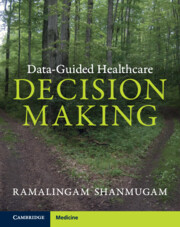Book contents
- Data-Guided Healthcare Decision-Making
- Data-Guided Healthcare Decision-Making
- Copyright page
- Dedication
- Contents
- Figures
- Tables
- About the Author
- Preface
- Glossary
- Notations and Symbols
- Prologue
- Introduction
- Chapter 1 Why and How Healthcare Decisions Are Made
- Chapter 2 Are Data-Guided Healthcare Decisions Superior?
- Chapter 3 Software
- Chapter 4 How to Collect Authentic Data
- Chapter 5 Uncertainties and Their Impact on Healthcare Decisions
- Chapter 6 Why Models Are Important in Healthcare
- Chapter 7 How Healthcare Decision Trees Emerge and Function
- Chapter 8 How Are Group Decisions Practiced in Healthcare?
- Chapter 9 Tracing and Remedying Root Causes of Adversities
- Chapter 10 Healthcare Decision-Making for Cost-Effectiveness
- Chapter 11 Risk Analysis in Healthcare Decision-Making
- Chapter 12 Evaluation of Healthcare Programs
- Chapter 13 Six Sigma and Lean Management in Healthcare Sectors
- Chapter 14 Forecasting in Healthcare Sectors
- Epilogue
- Appendix Statistical Tables
- Index
- References
Chapter 14 - Forecasting in Healthcare Sectors
Published online by Cambridge University Press: 13 July 2023
- Data-Guided Healthcare Decision-Making
- Data-Guided Healthcare Decision-Making
- Copyright page
- Dedication
- Contents
- Figures
- Tables
- About the Author
- Preface
- Glossary
- Notations and Symbols
- Prologue
- Introduction
- Chapter 1 Why and How Healthcare Decisions Are Made
- Chapter 2 Are Data-Guided Healthcare Decisions Superior?
- Chapter 3 Software
- Chapter 4 How to Collect Authentic Data
- Chapter 5 Uncertainties and Their Impact on Healthcare Decisions
- Chapter 6 Why Models Are Important in Healthcare
- Chapter 7 How Healthcare Decision Trees Emerge and Function
- Chapter 8 How Are Group Decisions Practiced in Healthcare?
- Chapter 9 Tracing and Remedying Root Causes of Adversities
- Chapter 10 Healthcare Decision-Making for Cost-Effectiveness
- Chapter 11 Risk Analysis in Healthcare Decision-Making
- Chapter 12 Evaluation of Healthcare Programs
- Chapter 13 Six Sigma and Lean Management in Healthcare Sectors
- Chapter 14 Forecasting in Healthcare Sectors
- Epilogue
- Appendix Statistical Tables
- Index
- References
Summary
Healthcare administrators working in hospitals, clinics, government agencies, and financial and insurance institutions must probe whether the healthcare services they provide are effective, efficient, and optimal. Health economists and data analysts invest time and effort to project the future performance of the healthcare services their institutions provide. These and related concerns could be answered by time series data analysis and forecasting. Hospital/clinic administrators, healthcare professionals, insurance agents, and patients all desire high-quality healthcare services utilizing a minimal amount of resources.
Developed and developing nations alike notice a percentage of their populations has inadequate health insurance coverage. Resources providers encounter restrictions that forbid financial support to underserved populations, including those with no health insurance coverage. Attempts have frequently been made to raise efficiency and cost-effectiveness in healthcare services. However, to achieve these goals, background knowledge and skill are essential and good understanding of forecasting methods can help healthcare administrators learn, apply, and utilize data to attain their goals. Every constituency involved in healthcare is aware of the necessity to improve the quality of healthcare services on a daily or a periodical basis.
- Type
- Chapter
- Information
- Data-Guided Healthcare Decision Making , pp. 426 - 458Publisher: Cambridge University PressPrint publication year: 2023



